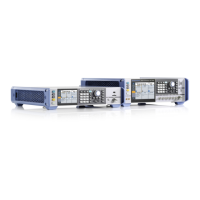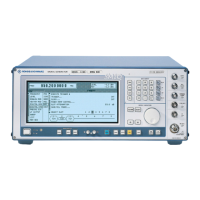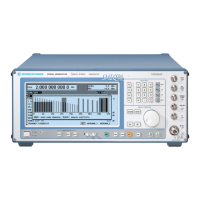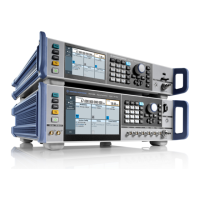SYSTem SME
1038.6002.02 3.120 E-13
:SYSTem:MSEQuence:FREE?
The command queries the space available for memory sequences. It returns two values. The first
value indicates the space still vacant, the second the space already occupied.
Example: :SYST:MSEQ:FREE? Response: 20, 236
:SYSTem:MSEQuence:MODE AUTO | STEP
The command indicates in which way the memory sequence is to be processed (by analogy with
:SOURce:SWEep:MODE) .
AUTOEach trigger event triggers a complete cycle of the memory sequence selected.
STEP Each trigger event only triggers one step in processing the memory sequence.
Example: :SYST:MSEQ:MODE AUTO *RST value is AUTO
:SYSTem:MSEQuence[:RCL] 1 to 50 {,1 to 50}
The command transmits the list of the instrument states to be assumed successively. The list
contains integers denoting the states stored by means of *SAV. These instrument states are set
successively using a simulated *RCL (thus the name of the list). The length of the list is not
limited. The values of the list are between 1 and 50 (number of memory locations to be called).
Lists are not influenced by *RST.
Example: :SYST:MSEQ:RCL 30, 31, 32 ,32 ,32 , 33
:SYSTem:MSEQuence[:RCL]:POINts?
The command queries the length of the RCL list selected. The RCL list is user-defined and of
variable length. The maximal length of the list can be queried by means of
:SYSTem:MSEQence:FREE? (addition of the two values)..
Example: :SYST:MSEQ:RCL:POIN? Response: 17
:SYSTem:MSEQuence:SELect "Name of sequence"
The command selects a memory sequence. The name of the sequence may be an arbitrary
character string of up to 7 letters. If there is no memory sequence of the name indicated, the
command creates it, i.e., this command can be used to generate new lists.
Example: :SYST:MSEQ:SEL "SEQA"
:SYSTem:PRESet
The command triggers an instrument reset. It has the same effect as the RESET key of the
manual control or as command *RST. This command triggers an event and hence has no *RST
value.
Example: :SYST:PRES
:SYSTem:PROTect1|2|3
The commands to disable certain instrument functions are under this node. A list of the functions
concerned can be found in the manual control (Section Password Input With Protected
Functions). There are three protection levels which are differentiated by means of a suffix after
PROTect. *RST has no effects on the disabling/enabling of the instrument functions.
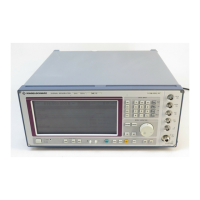
